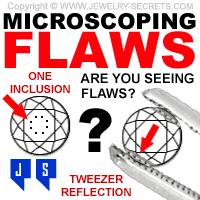MICROSCOPING INCLUSIONS AND CLARITY
ARE INCLUSIONS IN A DIAMOND A FLAW OR NOT?
This post contains affiliate links. If you use these links to buy something I may earn a commission. Thanks! As an Amazon Associate I also earn from qualifying purchases.

You must microscope!
Never buy a diamond that you don’t microscope first.
You want to view that diamond at 10x (ten powered) magnification. That’s what a diamond is graded with, that’s what you should view it at.
If you don’t scope it (with a microscope or a 10x jeweler’s loupe), you really don’t know what it is you’re buying.
And, even if you do microscope the diamond, understand that things are not always what they seem.
A diamond could look clean under magnification… but that could be wrong.
A diamond also could look extremely included (flawed)… this could also be wrong.
To microscope a diamond, you should learn these 4 important microscopic tips:
1) Diamond Focus:
When you microscope a diamond, you aren’t ever seeing the entire diamond at once.
10x magnification is so powerful, that you are only seeing a small range at any given time.
Think about a camera as an example. When you take a close up picture using a macro lens (close up lens like these made for the iPhone), you’ll notice that even the slightest little movement, like the wind blowing or your own breathing can be enough to throw the item out of focus. That’s the power of close ups.
Anytime you are zoomed all the way in, you are only seeing one section in focus at a time.
Everything else will be blurry.
Magnification is limited in depth.
When you’re viewing a diamond under a microscope, you’re either looking at the top of the diamond, the middle of the diamond, or the base of the diamond… not the entire stone.
So a diamond could look clean and free of inclusions, but by adjusting the focal lens up or down could bring unseen flaws into focus. To clearly see everything that is inside a diamond, you need to move the knobs on the microscope and look at the entire depth from head to toe.
2) Fun House Mirrors:
Diamonds are cut at such an angle on the bottom of the stone (the pavilion), that it acts like a fun house effect… a fun house full of mirrors.
This means that one single inclusion near the bottom of the stone could actually get reflected around and mirrored to make that one inclusion look like 8 instead. (see picture above)
So a diamond that’s pretty clean, could look like it has a lot of flaws. Which may also make you think that the clarity of the diamond is worse than it really is.
This fun house effect is also what helps light bounce around and come back out in a million flashes of beautiful sparkles.
So you see, the way a diamond is cut has it’s own ups and downs.
3) Hidden Inclusions:
If you’re viewing a diamond that’s already set in a head or mounting: BEWARE!
The prongs or mounting holding in your diamond could be covering up flaws and imperfections on the outside of your diamond.
Prongs could be hiding a chip, crack or black carbon spot. This is why I always say “If you’re buying a diamond, always buy it loose.” Buy it loose, then have it mounted later.
That way, you can view the diamond from all angles, from the side, and from the bottom before you buy it.
Plus, you’ll be able to see the laser inscription easier as well (if the stone is laser inscribed).
After you choose the diamond, then worry about choosing the mounting and having it set (I always recommend pave or halo settings).
4) Tweezer Reflections:
Some people see flaws in the stone… but, a lot of times what they’re seeing isn’t a flaw, it’s a reflection.
Diamonds reflect their surroundings. So if a diamond is being held by a pair of tweezers to view it under a microscope, those tweezers will be reflected inside the diamond (see picture).
Same with a mounting. Viewing a diamond already set will reflect that mounting into the diamond. Are you seeing flaws? Or are you seeing the surroundings?
The bottom line:
Things are not always what they seem.
Sometimes a flaw is a flaw, other times it’s not.
Don’t be afraid to rotate the diamond, view it from all angles, sides and focal points (like these diamonds here at James Allen).
Use the microscope:
Play around with the focus.
Microscopes are fun.
Because there’s nothing better than viewing diamonds at 10x magnification…
For the world inside a diamond is a terrible thing to miss.
Cheers! :)














Leave a comment